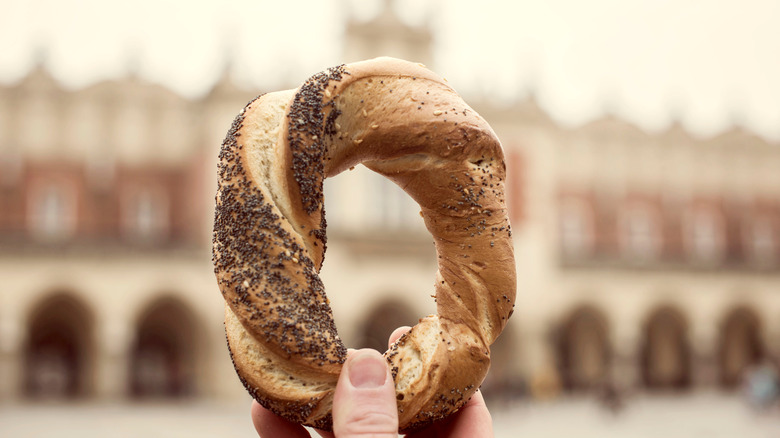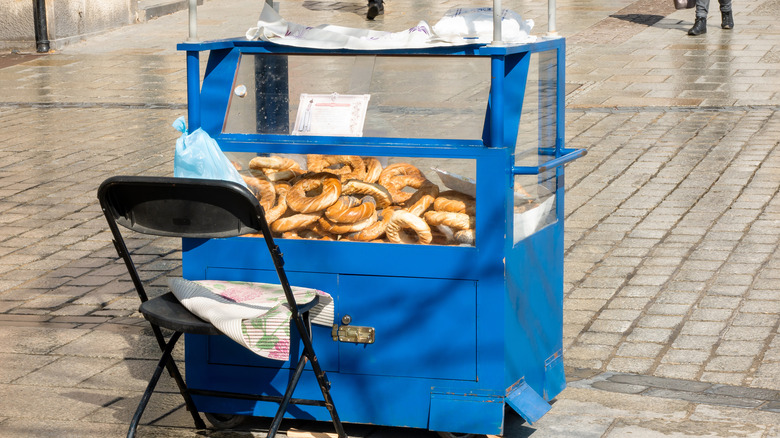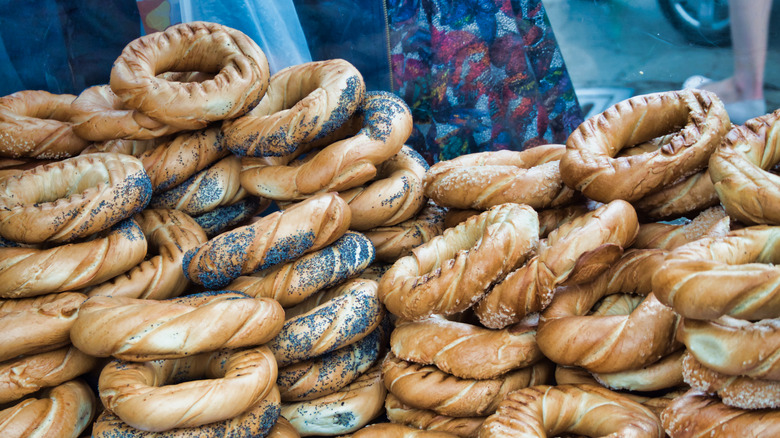Obwarzanek Krakowski: The Polish Bread That's Confused With A Bagel
Those who are laying eyes on an obwarzanek krakowski (pronounced: ob-VA-zhanek kra-KOV-ski, per How to Pronounce) for the first time might feel as though they are looking at a piece of bread with an identity crisis. It might look like a bagel, but it's texture is like a pretzel described as "a juxtaposition of a super crispy, flaky crust around a dense and soft interior," which is obtained by boiling, then baking the bread, per Polish Housewife. The obwarzanek isn't treated like a bagel either, since it can't be filled and eaten as a sandwich. Eat Polska says obwarzanek Krakowski is enjoyed like a German pretzel — eaten plain, with neither cheese fillings nor dips.
So what exactly is an obwarzanek krakowski?
In its application before the European Commission asking for the bread to be given protected status, a group of Polish bakers say the bread's origins has its roots in 15th century Krakow, when King Jan Olbracht granted the city's bakers sole permission to make white bread in general, and the specialty obwarzanek krakowski in particular. This royal warrant was said to have been extend repeatedly until the latter half of the 17th century. The obwarzanek were originally a treat during Lent, but Polish Housewife says that rule was relaxed in the mid 1800s, when the snack begun to be made and sold 365 days a year.
Obwarzanek are found everywhere in the Polish city of Krakow
Today the obwarzanek krakowski is a go-to treat enjoyed by tourists and locals in the Polish city of Krakow, where about 150,000 of are made and sold daily. Taste Atlas says they are beloved in the city that have made them their own, and they are sold everywhere in Krakow.
While the obwarzanek now enjoys an identity that is distinct from that of the bagel, it wasn't always that way. Before it became a product whose identity and production methods were protected by EU law, some cookbook authors like Maria Balinska would say that the obwarzanek and the bagel, which share a common shape, might have also shared a common history. Balinska told The Wall Street Journal in 2010 that "There's a shared history, and at one point I'd argue they were synonymous, but today... [the obwarzanek is] a very different product than what you'd get at Dunkin' Donuts or even at a smaller bakery in the U.S."
The obwarzanek became the center of controversy
Because it was granted protection as an EU product in 2010 per Krakow Post, there are now specific laws that define exactly what the obwarzanek krakowski is — and isn't. Per its filing with the European Commission, the bread must be made by "strands of dough twisted into a spiral," and should be 12-17 centimeters (4.7 to 6.69 inches) in diameter and weigh between 80 to 120 grams (2.82 to 4.23 ounces) apiece. It is meant to be slightly sweet and decorated with a range of spices, seeds, and mixed herbs. Most importantly, it must be made within the city limits of Krakow by hand. If a baked item falls outside of those parameters, then it cannot be considered a real obwarzanek.
Those strict definitions of what is — and what isn't an obwarzanek kicked off a small controversy in Krakow in 2011 a year after the designation was granted, because one firm had been forced to call their product something else when it was discovered that their bread was being made by machines in an incident the Krakow Post referred to as "Pretzel Wars".
Today, Polish Housewife says Krakow's street treat which is both bagel and pretzel is used to promote the city itself — it even has its own museum, where tourists can drop by and learn to make the treat. It might be time to plan a trip to Poland!


